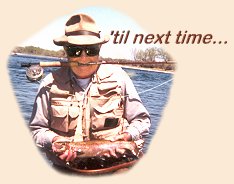
| ||
|
April 4th, 2005
|
|
Q. I would like to know the best reference book for identifying primarily eastern species of stream insects, preferably one that gives scientific names and good color photos.
A.
That's a pretty tall order. Most taxonomic texts
contain keys to identify the insects and include
their scientific names - usually, at least, family
and genus. Not all reference works contain identifying
keys to species because, in many cases, we still
do not have enough information to separate all
specimens to this level; this is especially so
for the immature nymphs and larvae. Adults have
been identified to species. However, most of
these publications do not contain color photos -
at least not to all genera or species.
You must also remember that any reference book
will not be complete in terms of addressing all
species of all stream insects. There are over
1000 species of aquatic and semi-aquatic beetles,
over 3,500 species of dipterans (midges, true flies),
over 700 species of mayflies, over 500 species of
stoneflies, and over 1,350 species of caddisflies
in North America. That's a lot of bugs to describe,
let alone photograph. Individual streams commonly
contain around 200 different species of insects and
Upper Three River Run in So. Carolina contains over
500 species.
The point of this discourse is to help you realize
that whatever book I suggest will have its pros and
cons in terms of your request. One book might be
better than another in terms of actual keys and
identifications, but another might be better for
photographs. Also, some references contain broad,
but less detailed information on many insect groups
whereas another that emphasizes a particular group,
such as caddisflies, will have more detail. So,
with all the above cop-outs and caveats, I would
suggest the following as the best all-around
references - and note that except for Peckarsky's
book, they are NOT restricted to eastern streams.
Peckarsky, B.L., P.R. Fraissinet, M.A. Penton, and
D.J. Conklin, Jr. 1990. Freshwater macroinvertebrates
of northeastern North America. Comstock Publ./Cornell Press.
McCafferty, W.P. 1981. Aquatic entomology.
Jones and Bartlett Publishers.
Merritt, R.W. and K.W. Cummins (eds.). 1996. An
introduction to the aquatic insects of North America,
3rd. ed. Kendall/Hunt Publ. Co.
A new edition of this book is in the works.
Schwiebert, E. 1973. Nymphs, a complete
guide to naturals and imitations. Winchester Press.
In summary, if your main interest is in insect
identification, I'd recommend Peckarsky et al.
or Merritt and Cummins. If you want color and
more general information, I'd pick McCafferty.
~ Bert
If you have a question, please feel free to contact me.
|
| If you would like to comment on this or any other article please feel free to post your views on the FAOL Bulletin Board! |
[ HOME ]
[ Search ] [ Contact FAOL ] [ Media Kit ]
 The 'Stream Doctor' is a retired professional stream ecologist and
author, now living in the West and spending way too much time
fly-fishing. You are invited to submit questions relating to
anything stream related directly to him for use in this Q & A Feature
at
The 'Stream Doctor' is a retired professional stream ecologist and
author, now living in the West and spending way too much time
fly-fishing. You are invited to submit questions relating to
anything stream related directly to him for use in this Q & A Feature
at